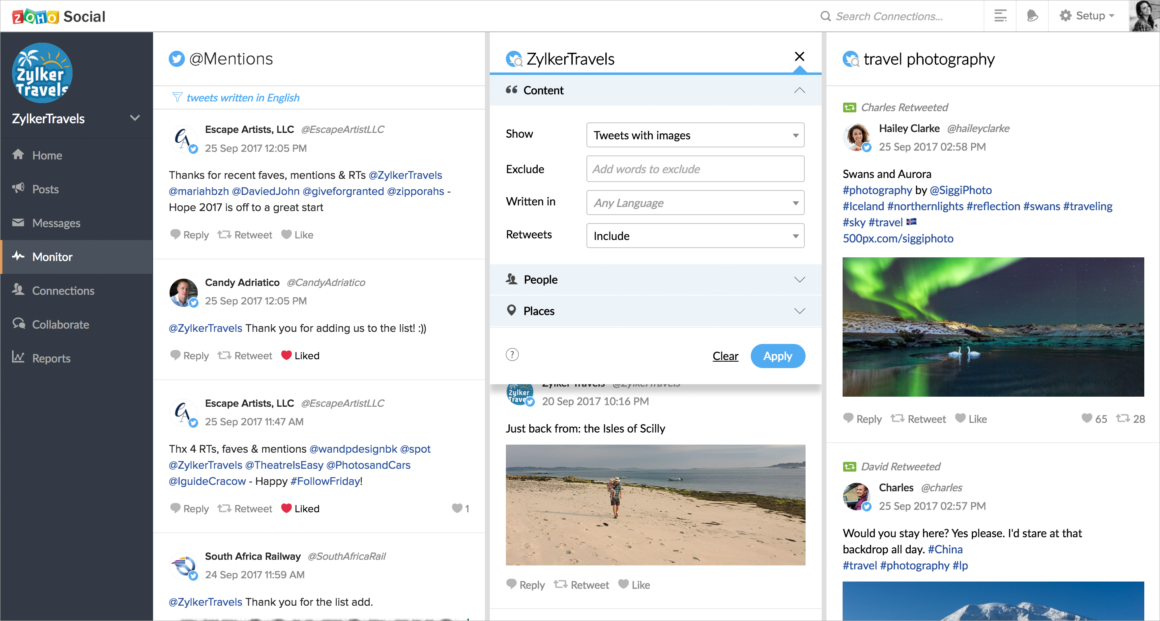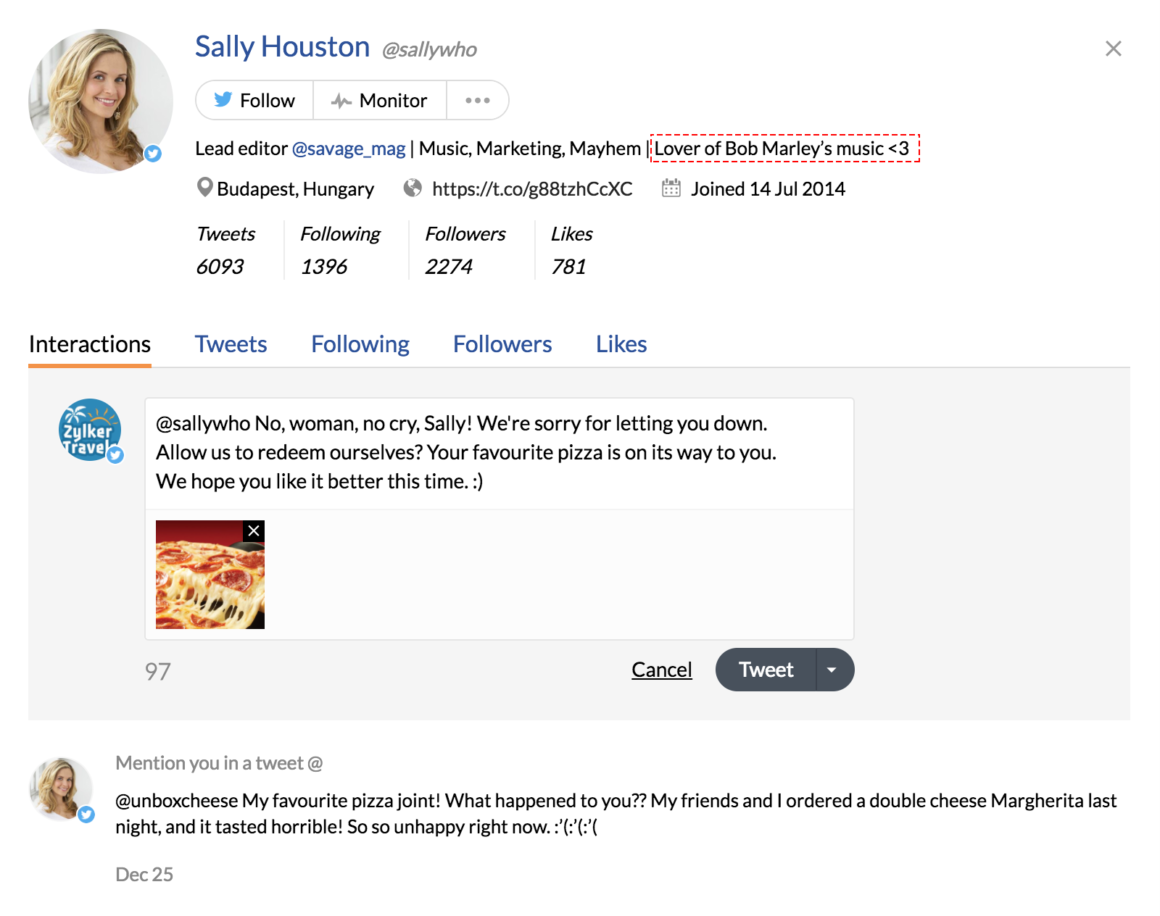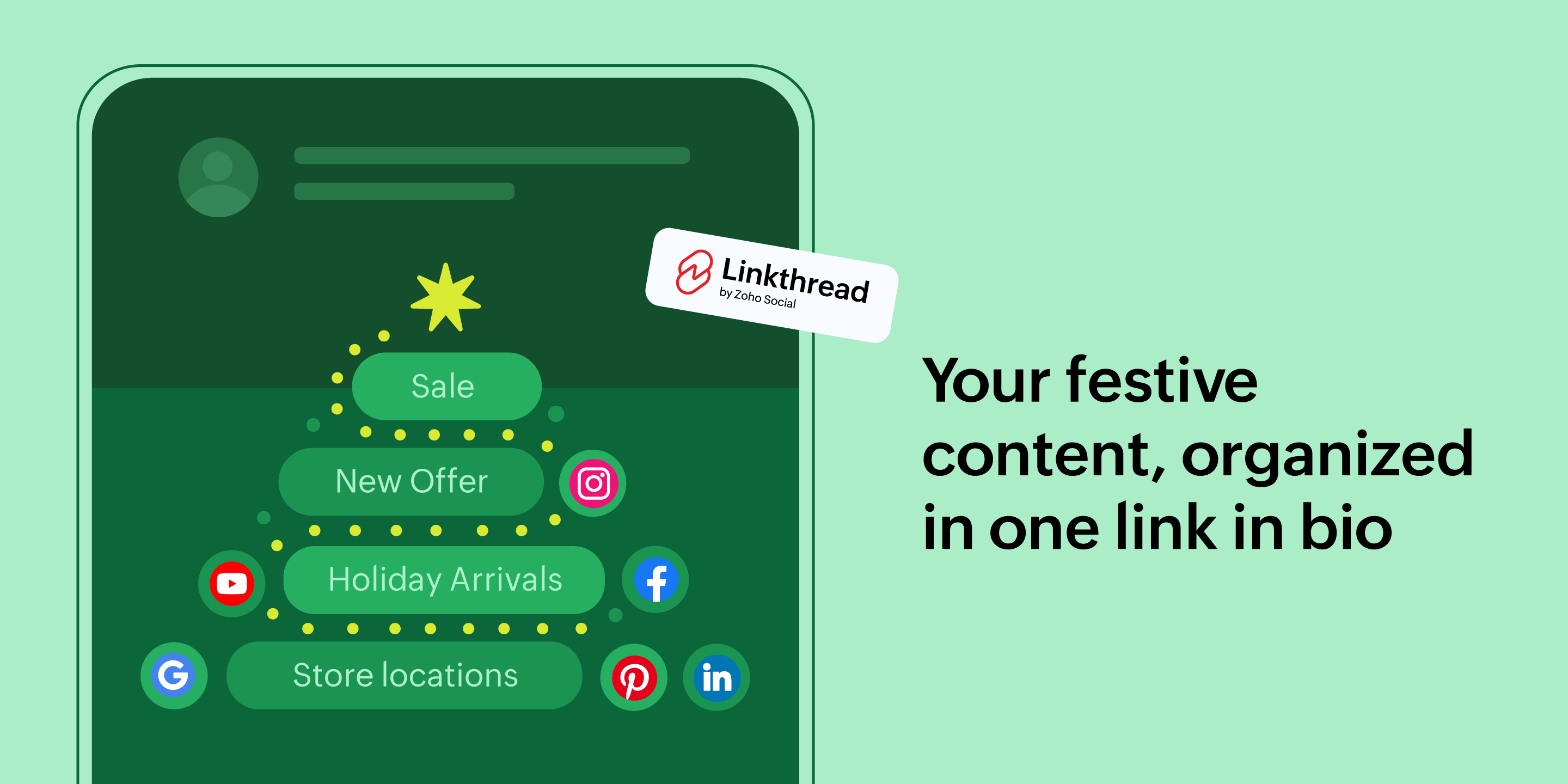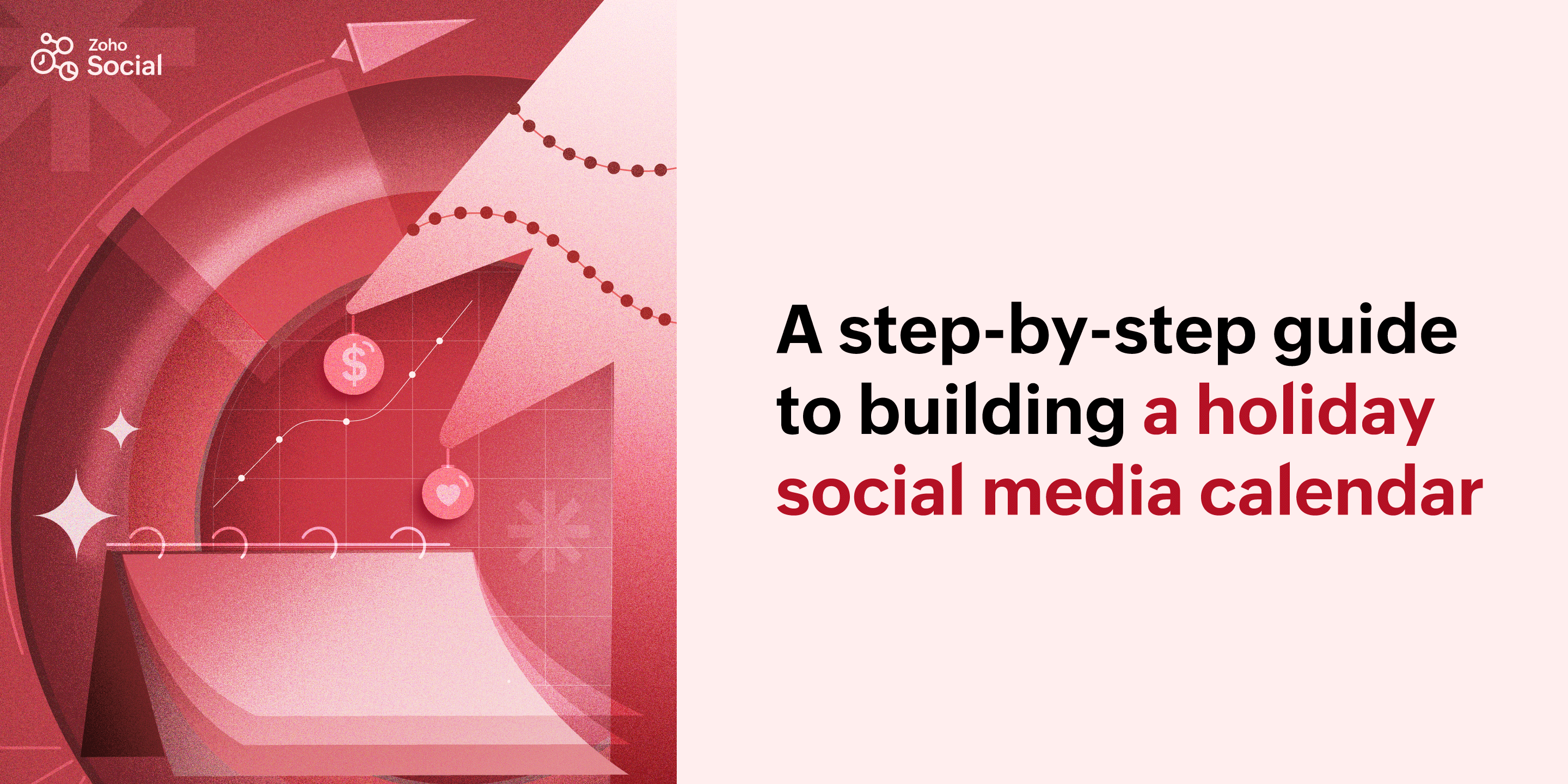5 ways your brand can benefit from using a social media monitoring dashboard
- Last Updated : August 17, 2023
- 45.9K Views
- 6 Min Read
With 3.81 billion people actively using social media, you can’t really trust that your audience will fall right into your lap, now can you?
Only a tiny fraction of those billions of people matter to you—the ones who could be your customers, prospects, or competitors’ followers. But even for that tiny fraction, what are the chances of you being able to effectively find, reach, and engage them in the huge sea of social media?
Sure, you’ve done your bit by crafting awesome content, scheduling different types of posts with the help of a calendar, and finally publishing them to reach your audience. You have a pretty good head start on your social media marketing goals, but, you can’t stop working just yet.
What do you do next?
Grab a front-row seat
Suppose you get a like on Facebook, or maybe a couple of comments. Someone follows you on Twitter. Nice! Even better, a potential customer shares your ad, but then your competitor counteracts it with a strong message of their own. Drat! Now some of your customers have started a hashtag trend that boosts your rival. Double drat!
Wouldn’t you like a front-row seat to watch and listen to these interactions so you can respond when the time is right?
Whether people are talking to you or about you, having the right social media monitoring platform in place helps you track conversations that are relevant to your business.
What can you do with a monitoring dashboard?
#1 Create specific columns to track your social media updates
The easiest and fastest way for people to get a brand’s attention is by mentioning them on social media. Whether they’ve tagged you in a Facebook post (Hey TheKenWeb, check out my latest article), used an Instagram hashtag (#SMMW18), or simply included your brand name in a tweet, you need to see what your customers are saying. A listening dashboard allows you to monitor updates across popular networks and organize them by type, audience, content, or other helpful categories.
The best part about having your updates organized into columns is being able to easily discover different types of audiences that are showing interest in your brand. You can find your existing customers, prospects, and even top influencers.
Tip: Try adding all your leads to a List on Twitter and creating a column for it. Then you can follow all of your leads’ social activities right from your dashboard.
Audiences aren’t all you can find. Sometimes, the best strategy is to keep an eye out for conversations that are yet to happen. If you’re planning a hashtag for an upcoming event, you can create a column to watch it before the event has even taken place. When the tweets start coming in, you’ll be the first one to see them.
Keywords, Users, Hashtags, Timelines, Page Mentions, and Visitor Posts are some of the many column types you can use to always be at the top of your social media monitoring game.
#2 Respond and engage in real-time
Do you want to build stronger connections and earn your prospects’ trust? Engaging with them in real-time will do the trick. If not, you could end up in an awkward position like Amtrak, who responded to a customer’s emergency tweet seven months late.
Ouch. Brownie points for the unintended humor, though.
Once you’ve got your timing down, the best way to maintain your brand’s persona is by being as authentic as possible. Take a look at this automated message:

My thoughts? Goodbye, computerized and completely devoid-of-feelings automation, and hello, fellow human!
A simple response that has an element of human touch can go a long way in establishing credibility for your brand. When you’d like your customers to advocate for you, it’s smart to listen to the 71% of consumers who’ve had positive social media experiences.
Moreover, I wouldn’t want your business to be in a tricky position like his:

#3 Keep your friends close, and your competitors closer
Step 1: Discover similar players in your market by creating relevant keyword search columns.
Step 2: See what kind of social media updates they’re making.
Step 3: Quickly identify their latest posts and prepare your responses.
Step 4: Plan ahead so you can beat them to it next time.
Social media monitoring isn’t always centered around what people are saying about your brand. In order to be the best in your market, you also need to understand how your competitors are performing. Be it a new feature update, a marketing faux pas, or a complaint, you can instantly act on your rivals’ social media activities and use them to your advantage. For instance, set up a Twitter user search column for your competitor so you can view conversations between them and their customers, find out where they messed up, and showcase your own brand in response.
Here’s an example of a recent goof from McDonald’s:
A quick-thinking competitor, Wendy’s, took advantage of the mistake to crack wise at their rival’s expense.
Your competitors can easily get ahead of you if you don’t keep up with their social media presence. But if you pay attention, sometimes they’ll give you the chance you need to take the lead.
Remember the Mercedes-Benz vs. Jaguar ad battle that went viral a few years ago? (I can’t seem to get enough of these. Apologies.)
 Having a good ear for real-time social media conversations, and acting on them instantly, can give you a definitive edge over your competition.
Having a good ear for real-time social media conversations, and acting on them instantly, can give you a definitive edge over your competition.
#4 Don’t just listen to what they’re saying, but also where they’re saying it
Do you love nerding out about how things originate and drilling down into the finest details?
We sure do.
What if you could do that with social media updates about specific keywords on Twitter?
Pick a monitoring tool that lets you narrow down your search results until you can focus on what really matters for your brand. Choose the type of media posts you want to see, exclude or include certain keywords, or search for tweets made by specific users—the deeper you dive, the more relevant the results become for you and your business.
And of course, it’s not just about the kind of posts your customers are engaging with, but also their geographical location. Whether you want to get a glimpse of how your local audience is responding to your brand or find out if you’re popular in other countries, an advanced search filter is a must for your monitoring dashboard. Here’s a look at how Zoho Social helps you monitor keywords and @mentions on Twitter.

#5 Know more about other brands and users
Finding out the number of people who liked, retweeted, or commented on your social media posts is great. But getting to know exactly who these connections are is equally important. Where do they come from? What are their interests? How influential are they? Could they be a strong lead? When was the first time they interacted with my brand? These are all possible questions that would likely cross your mind. When you’re looking to convert a lead into a customer, even the smallest piece of contextual information about them can have a huge impact on your interactions.
Here’s a hypothetical example:
There’s a user, Sally, who’s a big fan of Bob Marley, and then there’s UnboxCheese, a pizza brand. Two completely unrelated entities, right? (We’ll see)
Sally tweets at UnboxCheese stating that she was disappointed with the quality of their pizza when she ordered the previous night. They immediately make their way to her profile from the monitoring dashboard and discover something that they can use to win her back.
They decide to respond with their own spin on Bob Marley’s song “No Woman No Cry”:

A tweet like this will probably make Sally feel a bit better, don’t you think?
Moral of the story: Cut through the noise
Good social media marketing requires a lot of work. You have to monitor multiple people, multiple brands, multiple conversations, and multiple channels to keep your audience engaged. You’re going to need a way to cut through all of that noise.
A listening dashboard filters out the static and helps you focus on the signals that are important for your brand. When your customers reach out to you, you need to see their messages right away, not seven months later. And if you’re trying to make your brand known to new audiences, you need to see who, and where, they are. You don’t have enough time to read the entire internet every day, so why not let a listening dashboard do it for you?
Feel free to leave a comment and let me know if you found this helpful—or you could just tweet to us directly, and I’ll find you on my monitoring dashboard.
 Ritika
RitikaMarketing. Musings. Maple syrup.
Product Marketer at Zoho Social.




Comments(2)
What’s up, after reading this remarkable post i am as well happy to share my know-how here with mates.
Hi there! I’m glad you liked it. Yes, of course! Do share. We’d love to hear your thoughts ????